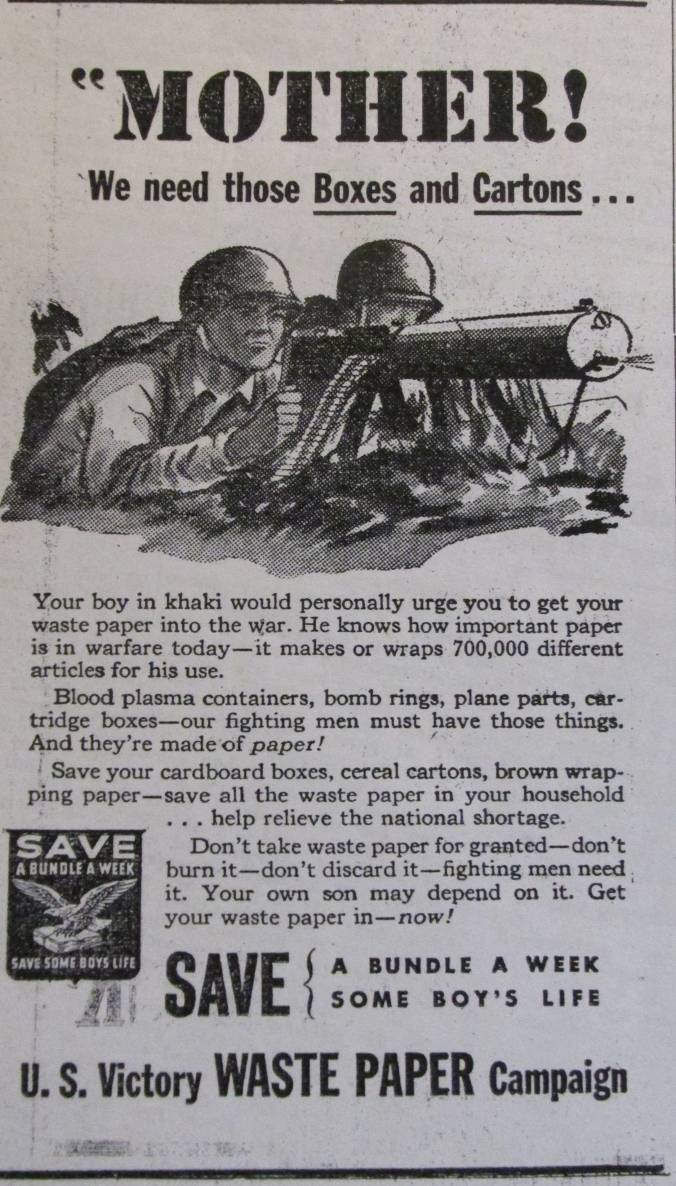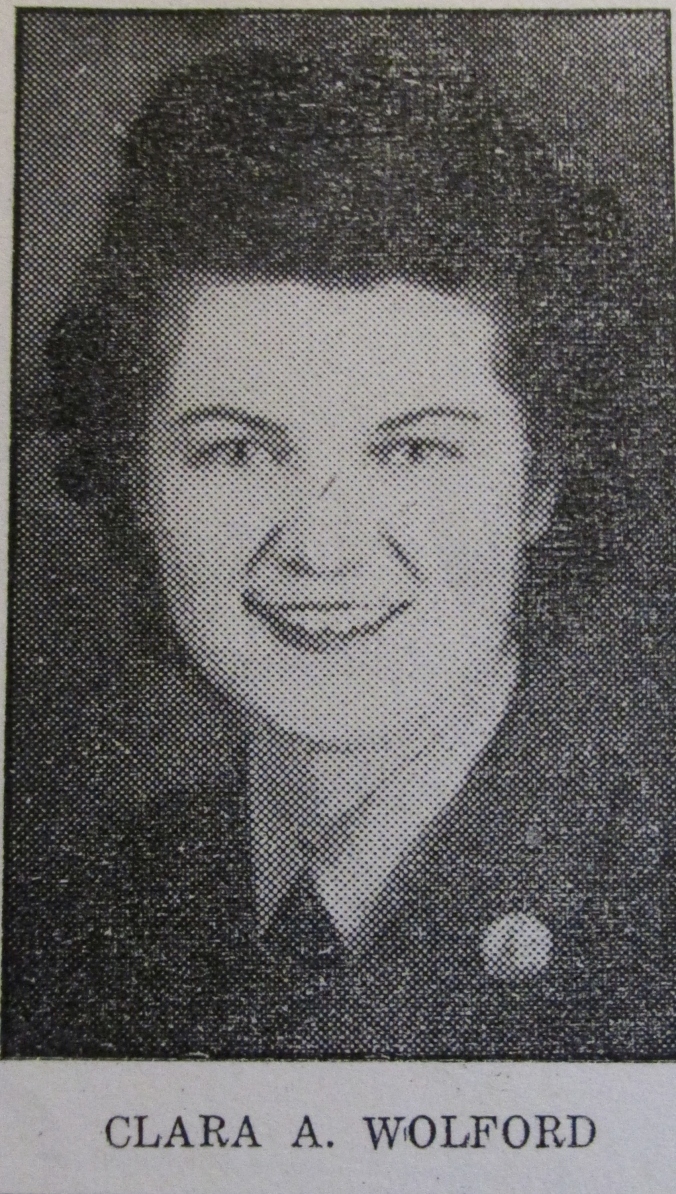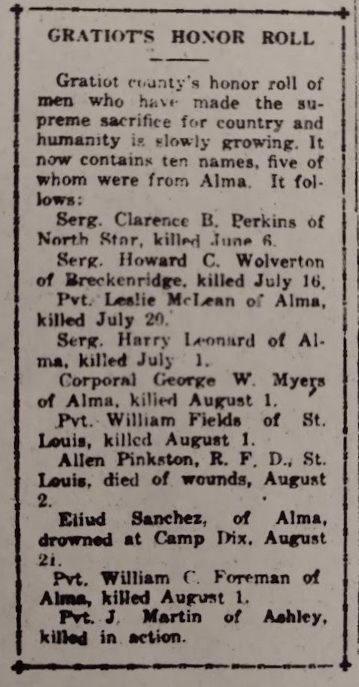




Above: Maps like this one kept Gratiot County readers informed about the geography of the war; paper drives called for people to donate for the war effort; Clara Wolford, from St. Louis, served as a WAC; Lt. Donald Curtis of Alma was KIA on a bombing mission over Germany. Images from January 1944 issues of the St. Louis Leader, Alma Record and Gratiot County Herald.
It had been 25 months since Pearl Harbor. Gratiot County had already been at war – twice the amount of time that it had been at war in World War I. This time the demands, commitment and support for this war proved to be much higher. There seemed to be no questions about loyalty. Almost everywhere in Gratiot County, people found a way to be involved in the war effort.
The enemy in this world war seemed to be much more easily defined. The Japanese had bombed Pearl Harbor. Hitler, Hirohito, Tojo, Mussolini – all were the faces of the enemy. However, this time, unlike 1917-1918, far more Gratiot County men would die before this war ended.
Many citizens did not ask what they could do to help Gratiot County in January 1944. They just asked how much. It was a different time.
By January 1944 the war seemed to be taking a turn in favor of the Allies and Gratiot County would start hearing the word “invasion.” The war fronts were moving. One of the places that people read about in January 1944 was a place called Italy.
If you had lived in Gratiot County in January 1944 you would have read about, heard about, or talked about:
Bonds, Rationing and Drives
Gratiot County heard the call to support the war effort by buying bonds in the Fourth War Loan Drive. Between January 18 and February 15, the nation planned to raise $14 billion for the war. Gratiot County’s quota was $1,173,000. In St. Louis, a kickoff breakfast took place at the Park Hotel, and Chairman John D. Kelley led the meeting where block leaders and workers heard about the goal of raising $67,000. Every township in the county had a goal, and every home could expect a visitor at their home asking for contributions. Under a column entitled, “YOUR RESPONSIBILITY,” The St. Louis Leader told readers that “Government bonds are the safest investment in the world. If they were to lose their value, there would be nothing left of value in this country…What are you going to do …while more than 1,500 Gratiot fighting men are risking their lives?” By the end of the first week, the drive raised $118,000. Ithaca Township purchased $14,512.50 worth of bonds or about 41 percent of its goal.
There were other ways to show support for the war. The Lansing State Board of Health planned on being in Alma in February with its mobile unit to collect blood from 360 residents. Those who wanted to donate only had to contact Dr. C.E. Burt of Ithaca, who chaired the blood plasma committee of the Red Cross. The Ithaca Boy Scouts collected over 8,000 pounds of scrap paper consisting of brown paper bags, cartons, newspapers, and items from wastebaskets. Even radio tubes were wanted. By the time they finished their drive, the troop had collected a total of nearly five tons worth of items. Ithaca read in the newspaper that “This is not a one-week or one-month campaign, but the saving of wastepaper must continue for the duration.” Another notice encouraged people to help with paper drives because one hundred pounds of waste paper made 50 .75 millimeter shell containers.
The Office of Price Administration (OPA) gave out 482 War Service Certificates to people in the Saginaw region who donated 100 or more hours to the War Price and Rationing Boards. Many of these recipients were from Gratiot County. These volunteers often served after their workday ended by answering phones, filing cards, and helping to issue gas ration cards. The OPA did announce that ration stamps could be used in advance for meat. One provision under this announcement meant that farmers could sell half hogs or quarters of beef if buyers planned on freezing or canning the meat. Still, a person needed brown or red stamps to obtain meat.
Other people in Gratiot County also heard about the President’s Ball to be held in Alma on January 28. This event coincided with President Roosevelt’s birthday. The ball, as well as March of Dimes parties in various parts of the county, raised money to buy wheelchairs, braces, shoes and other articles for residents who had contracted infantile paralysis. Alma’s Booster Club Hall, St. Louis High School’s gymnasium and the St. Louis Masonic Hall were a few of the places to host these parties.
The Red Cross
During the war, the Gratiot County Red Cross proved to be very active. The Red Cross chapter in Ashley commemorated its first anniversary on January 7 by publishing a report of its work. In the past year, a total of 96 workers had contributed 3468 hours, had made approximately 50,000 dressings, including pads and sponges. The chapter operated Wednesday and Thursday afternoons and evenings and was chaired by Mrs. F.E. Robbennolt. Ralph Tweedie kept and maintained fires in the building throughout 1943 for these meetings.
A countywide call for more Red Cross workers came from Mrs. Charles Bloss, who served as the County Production Chairman of Sewing and Knitting. A notice in the Gratiot County Herald read, “There is a need for Red Cross sewing and knitting to be done. Now that the holidays are over, can we not get this work ready for our men in service at an early date?”
An essential function of the Gratiot County Red Cross involved supporting families whose men became Prisoners of War. Private Bruce Mead of Riverdale was captured and sent to Stalag 2-B in Germany. Mead had been a captive for over a year, and a letter he wrote in late August 1943 appeared in the newspapers. Mead said that he continued to serve as a medic in the camp, had just received some reading material, and he had met many other POWS from various countries. In the letter, he asked for toiletries, candy, things to read and peanuts “if it isn’t too much trouble.”
The Draft – Off to War
Selective Service announced that it would provide at least a three-week notice to men for induction to the military. It also hoped to drastically curb the issue of occupational deferments for 18 to 21-year-old men, making another 115,000 non-fathers available to the nation. The over 400,000 farm workers in that age group remained unaffected, as well as those who came under industrial deferments. However, occupational deferments would no longer be granted to men under the age of 22. In February, all men listed as 2C and 3C draft registrants would be under review. This group consisted of men classified as necessary for agriculture. C.P. Milham, Gratiot County Agricultural Agent, oversaw the issue of these classifications. The USDA War Board then would make recommendations to the Gratiot County draft board whether each essential registrant was to remain on the farm.
From Gratiot County, 15 men entered the service by January 20. The group made up of seven in the Army, four in the Navy, and four in the Marines. The Marines consisted of Bohus Chovanec (St.Louis), Dwayne Ancel (Wheeler), Wallace Humphrey (Elwell), and Gerald Knapp (Alma).
In other news, 33 high school boys from across the county, age 17 or older, took the Army Air Corps aviation cadet mental examination at Alma High School. A total of 29 passed the test and could go to Detroit for preliminary physical tests in February. If they passed the tests there, the boys would go to Kellogg Field in Battle Creek, Michigan.
Men and Women in the Service
The newspapers regularly published the names of men and women who left the county to serve in the various arms of the military. Tom Nurnberger, Jr., sent a cable to his parents in St. Louis about his promotion to the rank of major. Nurnberger entered the army three years earlier and served in England with 5th Corps of Engineers, Headquarters Division. Hugh Rodenbo from St. Louis, who was driving a truck for the army in England, also wrote to his parents that he had married Phyllis Franks, who was a Corporal in the English Army. Other county men like Seaman Myron Humphrey and Private Elmer Lint, both from Alma, ran into each other at the Stage Door Canteen in New York City. Humphrey wrote that he met movie star Wendy Barrie there. The USO offered the men tickets for a good meal at a café. The two also saw Tommy Dorsey play the Paramount Theater. The former pastor of the Alma Presbyterian Church, Albert J. Anthony, re-entered the service and reported for duty in September 1942. Anthony, a World War I veteran, served as a chaplain at Camp Fanning in Tyler, Texas.
Then there was news of men who were in combat. Corporal Jarold C. Brown of Ithaca served as a paratrooper in the New Guinea campaign and had recently seen action in the Markham Valley. Lieutenant Royal Klein, also of Ithaca, maintained his gun position aboard a B-17 even after being severely wounded by 20 mm shells from a German Focke-Wulf during a raid over the Ruhr Valley in Germany. The B-17, heavily hit with flak, limped back home with several injured crewmen. The plane was met and escorted by two British Spitfires back to England.
WAC Corporal Clara A. Wolford, St. Louis High School Class of 1938, served as a telephone operator at a switchboard handling war calls somewhere in England. Wolford entered the service at Daytona Beach, Florida on her twenty-second birthday in 1943. Marjorie Street, Phm 2/c, sent a letter home to her mother in Ithaca with grave news. Street wrote from a Charleston, South Carolina hospital that she was there with second-degree burns on her legs as a resulting from an accident when scalding liquid had accidentally spilled on her. She said that her status was improving, and she expected to recover. Mary Finette Marzolf, a WAVE from Ithaca, had been commissioned as an Ensign upon completion from officers training at the Naval Reserve Midshipman’s School at Northampton, Massachusetts. Marzolf was a former teacher before entering the service.
Here in Gratiot County, Seaman First Class Jon Slavik was home on leave after seeing action in the Mediterranean Theater. On one landing operation, his ship was torpedoed and Slavik was knocked unconscious by shrapnel. He managed to reawaken long enough to evacuate and spent an hour in the water before he was picked up. Slavik spent almost three months in tent hospitals in North Africa, as well as being hospitalized in St. Albans in Long Island, New York. For this, Slavik received the Purple Heart. He was one of three sons from an Ashley family, all who were in the war. Seaman First Class Joseph F. Divish of Perrinton also came home after seeing two years of fighting in Africa and Sicily. Divish had been at the Casablanca invasion, and his ship did patrol duty off of Gela, Licata and Palermo, Italy. He enlisted in the Navy two days before the attack upon Pearl Harbor.
Making the Ultimate Sacrifice
The saddest news from the war dealt with those Gratiot County families who heard that they had lost someone in the war. This news frequently came weeks after their deaths, primarily as a result of the length of time it took to get communications home from the front. Sergeant Paul Gay of St. Louis was killed in action over Germany on November 26, 1943. Gay had been aboard a B-17 over Germany. The family received notice that their son was missing in action on December 8, but it was over a month before confirmation of his death. Sergeant Gay’s last letters home, written in late November, made it back before Christmas. Gay entered the service in May 1942, and he was almost 30 years old.
Lieutenant Donald Curtis had been missing since November 29, 1944, over Germany. An Alma High School graduate, he worked at the Gibson Hardware Store. Many in Alma had hoped that he was still alive and the news of his death shook the community. Curtis had trained as a bombardier aboard a B-17 and entered the service on June 19, 1942, went overseas in May 1943 and was based in England.
People in Wheeler received tragic news in mid-January that Private Don Hartenberg, a Breckenridge High School graduate, had been killed while serving in the Fifth Army in Italy. Hartenberg, age 22, died December 8, 1944 – which was the first anniversary of his entry into the service. Before his service, Hartenberg worked for the Stork Oil Service.
And Let Us Not Forget That:
Blue Star Mothers Chapter No. 1 of North Star met at the township hall. It planned a chili dinner to raise money. The chapter was grateful for the comic books that students from North Star District No.1 school donated for soldiers to read at the Fort Custer hospital…The Ideal Theatre in Ithaca featured Betty Grable in “Coney Island”…”With the Colors” was a regular front page feature with the Gratiot County Herald. It highlighted where young men and women were stationed and how readers could send cards and letters. Frequently stories dealt with families with more than one son who was at war. During this month, Ithaca’s Jack and Dale Ecklebarger appeared in the feature…Farmers were told to ask for their ACP pay for plowing under clover, harvesting hayseed or signing their farm plan for 1944. They all had to sign a document SB-702 to get their money…The Gratiot County AAA announced that milk subsidy payments would be paid for those who qualified for October, November, December 1943. In Middleton, payments would be available at Maynard Dodge’s store…and, a new liquor law requirement in Gratiot County meant that purchasers and consumers of liquor between the ages of 21-25 had to carry a liquor purchase license. The license had to shown upon demand, and only the county clerk issued them.
These events, people, places and things all made up Gratiot’s finest hour in January 1944.
Copyright 2019 James M Goodspeed
